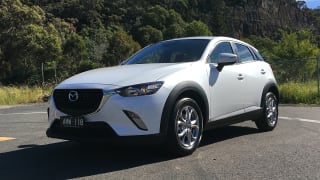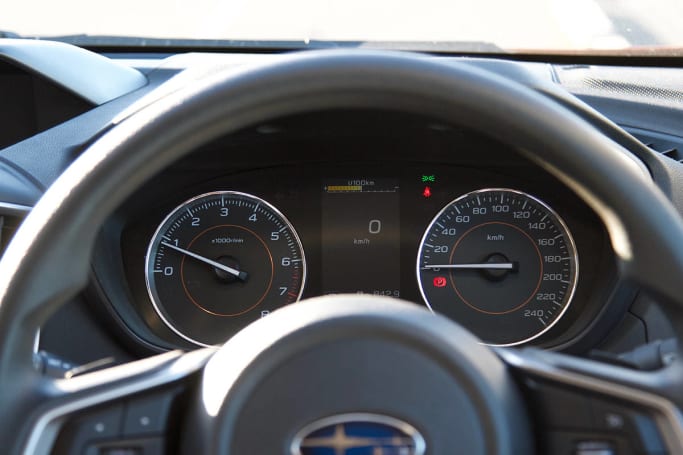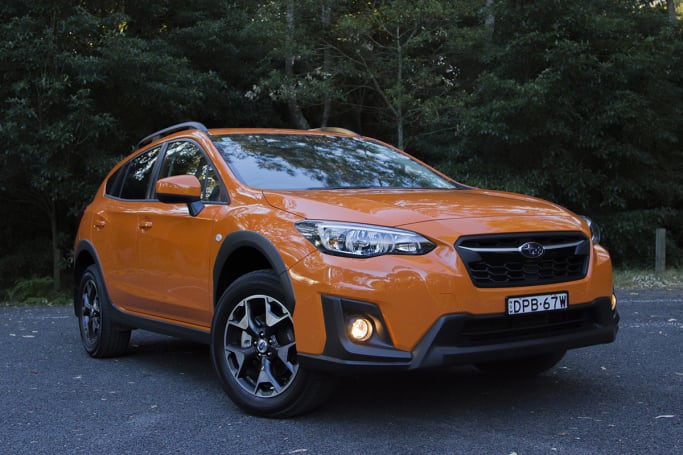
Mazda CX-3 Maxx 2017 review
The five-seat, five-door small SUV starts at $22,890 for a 2.0-litre four-cylinder petrol-powered front-wheel-drive manual version, rising to $24,890 for a six-speed auto.
Browse over 9,000 car reviews

Twenty years ago, someone at Subaru had the bright idea of taking the underbits of the popular Impreza, jacking it up and putting a roomier cabin with a chunky body around it. They called it the Forester, a nod to its more rugged looks and wild intent.
Australians lapped it up, and not just us, either. The world loves the Forester.
Donald Trump talks about loyalty, he should look at the way Subaru owners cling to the brand. But we're not here to talk about the Forester because as that car has grown in every dimension, particularly in height, Subaru has spied a gap in the market emerging underneath it.
The first time Subaru jacked up the Impreza and gave it a new identity, it worked. Then the smaller, less-rugged XV was born and truly it was a car only its mother could love. Still, Subaru picked it right again, and we lapped that up, too.
And so, 20 years after the first Forester comes the second-generation XV. Riding on the Impreza's new platform, the new XV is still, to be kind, challenging to look at. But if it's got the new and improved platform underneath, it's probably a better car. Right?
| Subaru XV 2017: 2.0i | |
|---|---|
| Safety rating | |
| Engine Type | 2.0L |
| Fuel Type | Regular Unleaded Petrol |
| Fuel Efficiency | 7.1L/100km |
| Seating | 5 seats |
| Price from | $19,580 |
I love the headline of this section - "Is there anything interesting about its design?" Hoo-boy. It's lovably ugly, which is kind of a Subaru design tradition that hasn't always worked well. People love Subarus in spite of how they look rather than because of it.
This car does exactly what it says on the tin and takes us back to the quirky Subaru we know and love. A ruggedised look, a raised ride height and lots of big chunky bits of black plastic, contrasting nicely with most of the range of flat (and all free) colour choices. It looks a bit odd in the metallics, if you're interested.
The new car has sorted out the jarring bits of the old, with sleeker headlights and bigger integrated-looking LED taillights. Despite sharing not a single exterior part with the old car, it's only a mild evolution that hides its growth in wheelbase (30mm), width (20mm) and extra length (15mm). Despite riding high, it no longer looks as out of proportion as its predecessor, although the 16-inch wheels look a bit lost in the wheelarches on the this base spec.
Inside there's been a gigantic improvement. The new dash is much easier to look at and feels a hell of a lot better. The front seats come in for particular praise from me - most recent Subarus I've driven feature flat, uncomfortable seats. the 2.0i's contrasting cloth-trimmed seats both look good and are much more comfortable. Materials are excellent throughout and make the car feel more expensive than it really is.


With the modest aforementioned dimension growth has come a bigger cabin. This is a particularly useful selling point in this part of the market, which is dominated by Mazda's CX-3 and Mitsubishi's ASX. The CX-3's cabin is tiny, the ASX's is bigger, but it's old.
Rear-seat passengers are big winners in the new XV, with more legroom and headroom, although the door aperture is a little more awkward than some in the class.
Boot space is probably where things fall down a bit. From a high loading lip, you have access to 310 litres (same as the old car), which isn't huge, and while the space between the wheelarches is wider it makes for a less than accommodating volume. Bigger prams might be a stretch.
The new XV range starts at $27,990 for the 2.0i, rising through the 2.0i-L, the 2.0i Premium and ending at $35,240 for the 2.0i-S. They're all petrol and all are all-wheel drive, as is Subaru's USP, via a continuously variable transmission. My steed for the week was the 2.0i range-opener, in a particularly vivid shade of orange, the hero colour for the original launch of this car and one of which owners of the first-gen XV seemed rather fond.
The 2.0i comes with 17-inch alloys, a six-speaker stereo, climate control, reversing camera, remote central locking, keyless start, cruise control, fog lamps, power windows and mirrors, rear window privacy glass, roof rails and a space-saver spare.
The interior is very much based on the Impreza's, and mercifully arrives with its upgraded bits. Subaru's Starlink powers a 6.5-inch touchscreen (further up the range it's an 8.0-inch unit), which also has Apple CarPlay and Android Auto, a rarity in compact SUVs. Of the three USB ports, you need to plug into the one under the dash to make that connectivity work. The six-speakers are a bit tinny, but do the job otherwise (our long-term Forester also suffers from tinny sound). The hardware is good - as it is in its sister car - but does take a while to boot up.
Common across the range is Subaru's characterful 2.0-litre four-cylinder boxer engine, making 115kW and 196Nm. Power is up over the old engine by 5kW to move the 1462kg XV. That "grunt" finds its way to all four wheels via a refreshed CVT, with seven steps built in to mimic a proper gearbox.

The claimed combined cycle consumption for the XV is 7.0L/100km and we got mighty close (with the usual margin for error) at 8.0L/100km. What's more, most of it was city running on urban motorways, four-up, and also battling traffic and creeping for parking spaces. Not bad at all.
Nobody will be surprised to read my biggest problem with the XV is its CVT - it makes what would be a slow-ish car even slower. As a concept, I dislike them in anything larger than a tiny hatchback with little torque. The XV isn't a small hatch with little torque.
Having said that, the CVT is okay - once you're moving it behaves a bit better than in the past but does buzz a bit and occasionally asks the engine to labour, eliciting a tappety sound that is unpleasant to the ear. It does kickdown when you floor the throttle, but it takes a while and, wouldn't you know it, I came to the conclusion a solid six-speed automatic would be a better bet.
That the CVT is the worst of it also speaks volumes about how much better this new XV is. The old car was already old when it was released. The cash-strapped Subaru, weathering the GFC, was not a company ready to throw a billion or two at a new platform.

The new chassis is much stronger and stiffer, with benefits flowing to ride and handling. With a 22cm ride height, it won't stay with cars like the CX-3 in the corners, but will leave it for dead in the slippery bits, more so when you hit the X-Mode button, which makes light work of heavy-going surfaces like mud and slush.
On the road, the XV is much quieter and more composed, with just a rustle of wind noise and distant tyre rumble. The steering is a bit isolated from the road surface, which is unnerving at first, but adds to the relaxed demeanour.
Basic Warranty
3 years / unlimited km warranty
ANCAP Safety Rating

The 2.0i is fitted with seven airbags (including driver's knee airbag), ABS, stability and traction controls, brake assist and a five-star ANCAP safety rating.
Sadly, unlike every other car in the range, you don't get Subaru's EyeSight safety system, which adds a ton of goodies including AEB (standard on all CX-3s, for example) and lane-departure assist. And it's not even optional, which is disappointing.
Subaru's three-year/unlimited-kilometre warranty covers the XV and your roadside assist needs are met for 12 months.
Fixed-price servicing is also offered for the first three years/37,500km, meaning you'll pay $348.50 for the first and third service and $601.59 for the second, working out at almost $1300 for three years' worth of visits. As the CVT has been improved and is also the only transmission available, service intervals have moved from six months to 12 months/12,500km.
Like the new Impreza, the XV is a vastly improved car. It's a far more competitive machine and is capable of conquest rather than loyalty sales - people will consider the XV for its size, dynamic ability, price and equipment, rather than just its Subaru badge and reputation. It's also a handily smaller car for those who find the new Forester a bit too big, with all of the benefits of a whole new box of bits underneath you.
| Vehicle | Specs | Price* | |
|---|---|---|---|
| 2.0i | 2.0L, ULP, CVT AUTO | $19,580 – 24,750 | 2017 Subaru XV 2017 2.0i Pricing and Specs |
| 2.0i-L | 2.0L, ULP, CVT AUTO | $22,440 – 27,720 | 2017 Subaru XV 2017 2.0i-L Pricing and Specs |
| 2.0i-S | 2.0L, ULP, 6 SP MAN | $22,660 – 27,940 | 2017 Subaru XV 2017 2.0i-S Pricing and Specs |
| 2.0I Special ED (pure Red) | 2.0L, ULP, CVT AUTO | $20,240 – 25,630 | 2017 Subaru XV 2017 2.0I Special ED (pure Red) Pricing and Specs |
| Design | 7 |
|---|---|
| Practicality | 7 |
| Price and features | 7 |
| Under the bonnet | 6 |
| Efficiency | 8 |
| Driving | 7 |
| Safety | 7 |
| Ownership | 7 |
$16,990
Lowest price, based on 111 car listings in the last 6 months